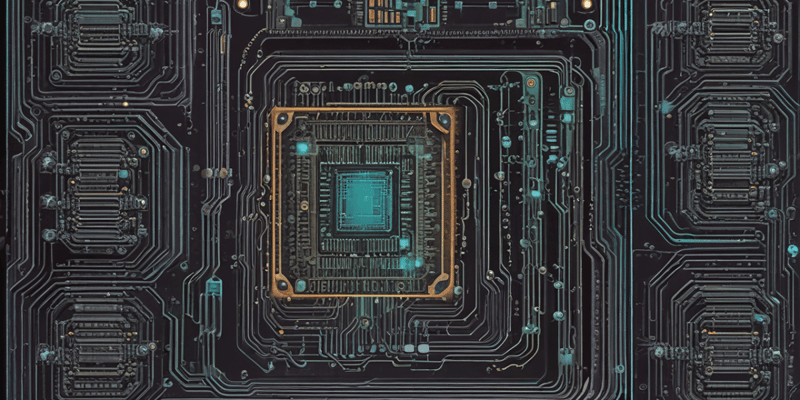40 Questions
What is the primary factor that determines program control in a dataflow computer?
Data dependencies
What do nodes in a Data Flow Graph represent?
Instructions
What happens when a node has all the required data tokens?
It fires and consumes the token
What is the role of an enabling unit in a processing element?
To accept tokens sequentially and store them in memory
What is the result of a node's operation placed on?
An output arc
What is a key advantage of Dataflow machines over other multiprocessor systems?
No cache coherency and contention problems
What is the characteristic of a Neural Network Computer?
It consists of a large number of simple processing elements
What type of problems are Neural Network Computers useful for?
Dynamic situations with accumulated past behavior and no exact algorithmic solution
What is the function of a functional unit in a Dataflow computer?
To create more tokens by computing output values
What happens to tokens after they are processed by a functional unit?
They are sent back to the enabling unit
What is the primary advantage of Processing Elements (PEs) compared to traditional microprocessors?
Their massively parallel architecture and ability to adapt
What type of learning algorithm do perceptrons use?
Supervised learning
What is the main challenge of using neural networks with more than 10-20 neurons?
Understanding how they derive meaning from complex data
What is the primary application of systolic array computers?
Image processing and sorting
What is the main limitation of traditional binary, transistor-based systems?
Difficulty in containing electrons
What is the primary advantage of quantum computers over classical computers?
Their ability to solve complex, intractable problems
What is Rose's Law?
A prediction of the doubling of operational qubits every 12 months
What is the main challenge of building quantum computers?
Correcting errors caused by qubit decoherence
What is the primary application of RISC processors?
Superpipelining and specialized instruction fetch/decode units
What is the primary classification of multiprocessor systems based on processors and data streams?
Flynn's Taxonomy
What is the key aspect of program control in a dataflow computer?
Data dependencies
What is the primary benefit of the massively parallel architecture of Neural Network Computers?
Increased processing speed
What type of learning algorithm do traditional perceptrons use?
Supervised learning
What is the purpose of an arc in a Data Flow Graph?
To indicate data dependencies
What is the role of a node in a Data Flow Graph?
To represent instructions
What is a key challenge of using neural networks with many neurons?
Difficulty understanding complex data
What is the primary function of a processing element in a Dataflow computer?
To communicate with other elements
What is the primary advantage of systolic array computers?
High throughput due to parallel processing
What is the advantage of Dataflow machines over traditional multiprocessor systems?
No cache coherency and contention problems
What is a limitation of traditional binary, transistor-based systems?
Difficulty in shrinking transistors
What is a key advantage of quantum computers over classical computers?
Ability to perform many operations simultaneously
What is the characteristic of a Neural Network Computer?
Small number of simple processing elements
What type of problems are Neural Network Computers useful for?
Dynamic situations with accumulated past behavior and no exact algorithmic solution
What is Rose's Law related to?
The doubling of operational qubits every 12 months
What is a key challenge of building quantum computers?
Error correction due to qubit decoherence
What happens when a node receives a token in a Data Flow Graph?
It extracts input tokens from memory
What is the role of a functional unit in a Dataflow computer?
To create more tokens
What is a characteristic of RISC processors?
Short, fixed-length instructions
What is the purpose of tokens in a Dataflow computer?
To enable node execution
What is Flynn's Taxonomy primarily concerned with?
Classifying multiprocessor systems
Study Notes
Program Control and Data Dependencies
- Program control is directly determined by data dependencies, with no program counter or shared storage available to multiple instructions simultaneously.
- Data Flow Graph represents computation flow in a dataflow computer, where nodes correspond to instructions and arcs indicate data dependencies.
Dataflow Computer Architecture
- Elements consist of processing elements that communicate with each other, with each element having an enabling unit that accepts tokens sequentially and stores them in memory.
- When a node receives a token, it extracts input tokens from memory, combines them with the node itself, and forms an executable packet.
- Functional Units create more tokens by computing output values and combining them with destination addresses.
Advantages
- Dataflow machines are not subject to cache coherency and contention problems that affect other multiprocessor systems.
Neural Network Computers
- Consist of a large number of simple processing elements that individually solve a small piece of a much larger problem.
- Useful in dynamic situations with accumulated past behavior and no exact algorithmic solution.
- Inspired by biological brains, allowing them to deal with imprecise information and adapt to interactions.
Processing Elements (PEs)
- Input values * weights = output value.
- Computation is simple compared to traditional microprocessors.
- Power comes from massively parallel architecture and ability to adapt.
Learning
- Learn from their environments through a built-in learning algorithm.
- Perceptron: simplest PE, trainable neuron with a Boolean output, trained by modifying threshold and input weights.
Training Methods
- Supervised learning: uses prior knowledge of correct results during training.
- Unsupervised learning: adapts to inputs, recognizing patterns and structures.
Challenges
- Difficulty understanding how networks with more than 10-20 neurons work.
- Can derive meaning from complex data unanalyzable by humans.
Applications
- Gaining credibility in sales forecasting, data validation, and facial recognition.
Systolic Array Computers
- Inspired by blood flow through the heart.
- Variation of SIMD computers with simple processors processing data through vector pipelines.
Advantages
- High throughput due to parallel processing.
- Short connections, simple design, scalable, robust, efficient, and cheap to produce.
Traditional Computers Limitations
- Binary, transistor-based systems struggle to meet increasing computational demands.
Alternatives
- Optics (photonic computing)
- Biological neurons
- DNA
- Shrinking transistors become unreliable due to difficulty containing electrons.
Quantum Computers
- Use quantum bits (qubits) that can exist in multiple states (superposition).
- A 3-bit quantum register can hold all values from 0 to 7 at once.
- Allows performing many operations simultaneously (quantum parallelism).
Architecture
- Not limited by fetch-decode-execute cycle, but lacks a definitive paradigm.
Rose's Law
- Predicts doubling of operational qubits every 12 months (observed for the past 9 years).
Definition
- Use quantum bits (qubits) that can exist in multiple states (superposition).
Applications
- Cryptography
- True random number generation
- Solving complex, intractable problems
Challenges
- Qubit decoherence leads to uncorrectable errors.
- Error-correction algorithms are promising, but require further research.
Technological Singularity
- Theoretical point of fundamentally altered human development due to technology.
RISC vs. CISC
- RISC uses short, fixed-length instructions and load-store architecture, enabling high pipelining.
Flynn's Taxonomy
- Classifies multiprocessor systems based on processors and data streams, but may not fully represent modern systems.
Massively Parallel Processors (MPP)
- Many processors with distributed memory, communicating through a network.
Symmetric Multiprocessors (SMP)
- Fewer processors with shared memory communication.
Superscalar Processors
- Characteristics include superpipelining and specialized instruction fetch/decode units.
Very Long Instruction Word (VLIW) Architectures
- Compiler creates long instructions instead of a decoding unit (unlike superscalar).
Vector Processors
- Highly pipelined processors operating on entire vectors/matrices simultaneously.
MIMD (Multiple Instruction Set, Multiple Data Stream) Systems
- Communication through blocking or non-blocking networks, with topology affecting throughput.
Multiprocessor Memory
- Can be distributed or a single unit, with distributed memory introducing cache coherency issues addressed by specific protocols.
Program Control and Data Dependencies
- Program control is directly determined by data dependencies, with no program counter or shared storage available to multiple instructions simultaneously.
- Data Flow Graph represents computation flow in a dataflow computer, where nodes correspond to instructions and arcs indicate data dependencies.
Dataflow Computer Architecture
- Elements consist of processing elements that communicate with each other, with each element having an enabling unit that accepts tokens sequentially and stores them in memory.
- When a node receives a token, it extracts input tokens from memory, combines them with the node itself, and forms an executable packet.
- Functional Units create more tokens by computing output values and combining them with destination addresses.
Advantages
- Dataflow machines are not subject to cache coherency and contention problems that affect other multiprocessor systems.
Neural Network Computers
- Consist of a large number of simple processing elements that individually solve a small piece of a much larger problem.
- Useful in dynamic situations with accumulated past behavior and no exact algorithmic solution.
- Inspired by biological brains, allowing them to deal with imprecise information and adapt to interactions.
Processing Elements (PEs)
- Input values * weights = output value.
- Computation is simple compared to traditional microprocessors.
- Power comes from massively parallel architecture and ability to adapt.
Learning
- Learn from their environments through a built-in learning algorithm.
- Perceptron: simplest PE, trainable neuron with a Boolean output, trained by modifying threshold and input weights.
Training Methods
- Supervised learning: uses prior knowledge of correct results during training.
- Unsupervised learning: adapts to inputs, recognizing patterns and structures.
Challenges
- Difficulty understanding how networks with more than 10-20 neurons work.
- Can derive meaning from complex data unanalyzable by humans.
Applications
- Gaining credibility in sales forecasting, data validation, and facial recognition.
Systolic Array Computers
- Inspired by blood flow through the heart.
- Variation of SIMD computers with simple processors processing data through vector pipelines.
Advantages
- High throughput due to parallel processing.
- Short connections, simple design, scalable, robust, efficient, and cheap to produce.
Traditional Computers Limitations
- Binary, transistor-based systems struggle to meet increasing computational demands.
Alternatives
- Optics (photonic computing)
- Biological neurons
- DNA
- Shrinking transistors become unreliable due to difficulty containing electrons.
Quantum Computers
- Use quantum bits (qubits) that can exist in multiple states (superposition).
- A 3-bit quantum register can hold all values from 0 to 7 at once.
- Allows performing many operations simultaneously (quantum parallelism).
Architecture
- Not limited by fetch-decode-execute cycle, but lacks a definitive paradigm.
Rose's Law
- Predicts doubling of operational qubits every 12 months (observed for the past 9 years).
Definition
- Use quantum bits (qubits) that can exist in multiple states (superposition).
Applications
- Cryptography
- True random number generation
- Solving complex, intractable problems
Challenges
- Qubit decoherence leads to uncorrectable errors.
- Error-correction algorithms are promising, but require further research.
Technological Singularity
- Theoretical point of fundamentally altered human development due to technology.
RISC vs. CISC
- RISC uses short, fixed-length instructions and load-store architecture, enabling high pipelining.
Flynn's Taxonomy
- Classifies multiprocessor systems based on processors and data streams, but may not fully represent modern systems.
Massively Parallel Processors (MPP)
- Many processors with distributed memory, communicating through a network.
Symmetric Multiprocessors (SMP)
- Fewer processors with shared memory communication.
Superscalar Processors
- Characteristics include superpipelining and specialized instruction fetch/decode units.
Very Long Instruction Word (VLIW) Architectures
- Compiler creates long instructions instead of a decoding unit (unlike superscalar).
Vector Processors
- Highly pipelined processors operating on entire vectors/matrices simultaneously.
MIMD (Multiple Instruction Set, Multiple Data Stream) Systems
- Communication through blocking or non-blocking networks, with topology affecting throughput.
Multiprocessor Memory
- Can be distributed or a single unit, with distributed memory introducing cache coherency issues addressed by specific protocols.
This quiz covers the basics of data flow computer architecture, including program control, data dependencies, and data flow graphs. It explores the elements of data flow computers and how they communicate with each other.
Make Your Own Quizzes and Flashcards
Convert your notes into interactive study material.
Get started for free


